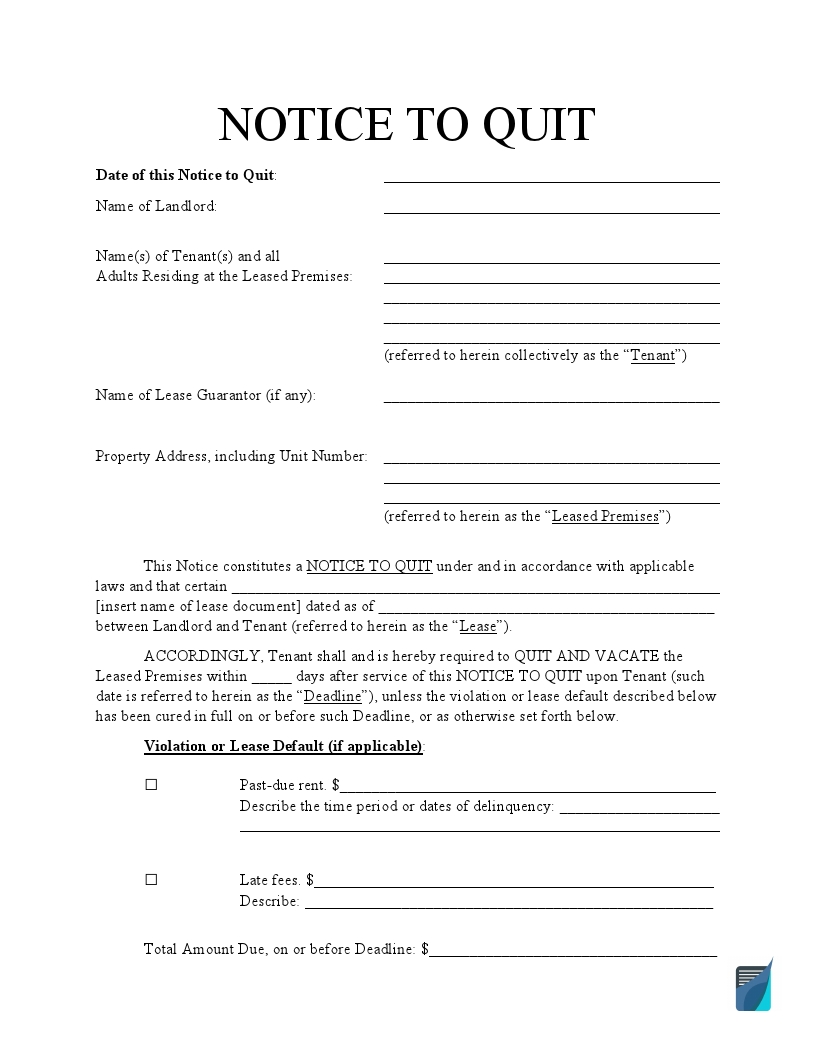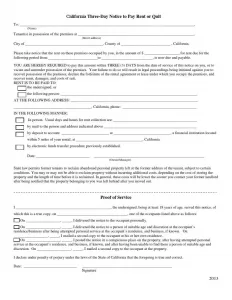California 3-day Eviction Notice Form
Lessor-lessee relations in California establish conditions to protect the interests of both members of any contract. For a lessor, it is critical to maintaining the security of their property and funds while the lessee tries to obtain a dependable landlord and a comfortable place to live. Unfortunately, sometimes the terms of the agreement get violated, and the parties fire a warning shot, which is legally called an eviction letter or eviction notice.
The most often reason for breaching a contract is the failure to provide rental payments by the tenant(s). This behavior is recognized as late rent. Lessor-lessee relations are regulated by §1161 of the California Code of Civil Procedure. Under the statutes, the lessor is empowered to claim the full rental sum serving a 3-day notice to provide rent or vacate the premises.
California eviction notice forms – this category will allow you to find out more about some other eviction notices used in California.

Build Your Document
Answer a few simple questions to make your document in minutes
Save and Print
Save progress and finish on any device, download and print anytime
Sign and Use
Your valid, lawyer-approved document is ready
A correctly completed 3-day eviction notice template for non-payment must contain:
- the landlord’s identification, including the legal name, physical address, and contact phone numbers
- the full outlay of rental debt
- a statement of an alternative to either provide the payment or vacate the dwelling unit
The property owner should keep the evidence that he or she has sent the 3-day eviction letter. A receipt or a certificate of service can prove that the notice was delivered during proper hours.
Once the lessee has obtained the 3-day eviction, he has 72 hours to cure the matter. Suppose the tenant ignores the notification or isn’t intended to provide rental. He or she must depart from the residence. If the lessee manages to fix the issue and render necessary charges, the tenancy continues successfully.
There are cases when the tenant is eager to pay but needs some time to collect the rent. The landlord may grant the other party extra time to fulfill the obligations. However, it is not a must. It all depends on the landlord’s desire to proceed with eviction or not.
There is one vital point that both parties must acknowledge. The lessor cannot demand that the overdue rent is only given in cash.
Below, you will find a helpful guide on how to fulfill a California 3-day eviction notice. We empower you to use the latest software on our website to generate a template easily and successfully.
California 3-Day Eviction Notice Form Details
| Document Name | California 3-Day Eviction Notice Form |
| Other Names | California 3-Day Notice to Pay or Quit, California 3-Day Notice to Vacate |
| Relevant Laws | California Code of Civil Procedure, Section 1161 |
| Avg. Time to Fill Out | 10 minutes |
| # of Fillable Fields | 41 |
| Available Formats | Adobe PDF |

Official Form Preview
California
To: ____________________________________________________________________________________________,
(Name)
Tenant(s) in possession of the premises at _____________________________________________________________,
(Street address)
City of _________________________________________, County of __________________________ , California.
Please take notice that the rent on these premises occupied by you, in the amount of $ __________________, for rent due for the
following period from __________________________to ___________________________, is now due and payable.
YOU ARE HEREBY REQUIRED to pay this amount within THREE (3) DAYS from the date of service of this notice on you, or to vacate and surrender possession of the premises. Your failure to do so will result in legal proceedings being initiated against you to recover possession of the premises, declare the forfeiture of the rental agreement or lease under which you occupy the premises, and recover rents, damages, and costs of suit.
RENT IS TO BE PAID TO: the undersigned, or
the following person: ________________________________________________________________________
AT THE FOLLOWING ADDRESS: ___________________________________________________________________
_________________________________________, California, phone: _______________________________________
IN THE FOLLOWING MANNER:
In person. Usual days and hours for rent collection are: ____________________________________________
by mail to the person and address indicated above _________________________________________________
by deposit to account _________________________ at ______________________________, a financial institution located
within 5 miles of your rental, at ___________________________________, California
by electronic funds transfer procedure previously established.
Date: ____________________________ __________________________________________________________
(Owner/Manager)
State law permits former tenants to reclaim abandoned personal property left at the former address of the tenant, subject to certain conditions. You may or may not be able to reclaim property without incurring additional costs, depending on the cost of storing the property and the length of time before it is reclaimed. In general, these costs will be lower the sooner you contact your former landlord after being notified that the property belonging to you was left behind after you moved out.
Proof of Service
I __________________________________________________, the undersigned, being at least 18 years of age, served this notice, of
which this is a true copy, on _____________________________________, one of the occupants listed above as follows:
___ On __________________, _____, I delivered the notice to the occupant personally.
___ On __________________, _____, I delivered the notice to a person of suitable age and discretion at the occupant’s
residence/business after being attempted personal service at the occupant’s residence, and business, if known. On
__________________, _____, I mailed a second copy to the occupant at his or her own residence.
___ On __________________, _____, I posted the notice in a conspicuous place on the property, after having attempted personal
service at the occupant’s residence, and business, if known, and after having been unable to find there a person of suitable age and discretion. On __________________, _____, I mailed a second copy to the occupant at the property.
I declare under penalty of perjury under the laws of the State of California that the foregoing is true and correct.
Date: ____________________________ _______________________________________________
Signature
2013
How To Fill Out California 3-day Eviction Notice Form
Identify the Lessee
Write down the resident’s legal name.

Identify the Dwelling Unit
Insert the complete address of the property that is in the lessee’s current possession. Include the street, city, county.

Specify the Character of Payment and the Period of Payment
Give a description of the overdue charges in dollars and insert the unpaid period of rental terms.
![]()
Identify the Recipient of Payment
If the landlord receives the payment, stick to the first alternative, which is the “undersigned”. If another individual receives the overdue on behalf of the landlord, use the second alternative, and specify the name, address, and contact phone numbers.

Define the Payment Method
This section provides four alternatives that the lessee can follow to render charges. The landlord should determine the preferred one. Thus, one should choose from:
- by electronic transfer, specified in the lease agreement
- paying in person with a specification of proper hours to collect the funds
- by deposit to the account, including bank specifications
- by certified mail, which involves defining the landlord’s address.

Authorize the Letter
The lessor should date the California 3-day eviction notice and certify it by his or her signature.
![]()
Complete the Proof of Service Section
Determine the delivery-person and the method of service (choose one). The one who delivers the letter will date the proof and place the signature.


We offer a multitude of major California forms to anyone seeking simplicity when filling out various agreements, contracts, and other paperwork in the state.